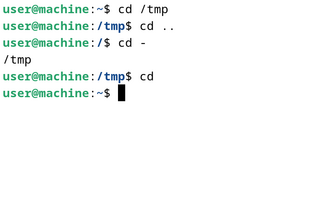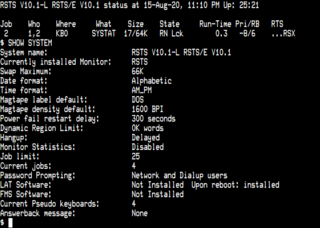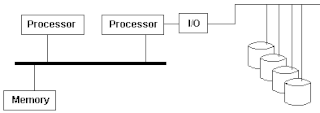Related Research Articles

Digital Equipment Corporation, using the trademark Digital, was a major American company in the computer industry from the 1960s to the 1990s. The company was co-founded by Ken Olsen and Harlan Anderson in 1957. Olsen was president until he was forced to resign in 1992, after the company had gone into precipitous decline.

A shell script is a computer program designed to be run by a Unix shell, a command-line interpreter. The various dialects of shell scripts are considered to be command languages. Typical operations performed by shell scripts include file manipulation, program execution, and printing text. A script which sets up the environment, runs the program, and does any necessary cleanup or logging, is called a wrapper.

OpenVMS, often referred to as just VMS, is a multi-user, multiprocessing and virtual memory-based operating system. It is designed to support time-sharing, batch processing, transaction processing and workstation applications. Customers using OpenVMS include banks and financial services, hospitals and healthcare, telecommunications operators, network information services, and industrial manufacturers. During the 1990s and 2000s, there were approximately half a million VMS systems in operation worldwide.
RT-11 is a discontinued small, low-end, single-user real-time operating system for the full line of Digital Equipment Corporation PDP-11 16-bit computers. RT-11 was first implemented in 1970. It was widely used for real-time computing systems, process control, and data acquisition across all PDP-11s. It was also used for low-cost general-use computing.

The cd command, also known as chdir, is a command-line shell command used to change the current working directory in various operating systems. It can be used in shell scripts and batch files.

Ultrix is the brand name of Digital Equipment Corporation's (DEC) discontinued native Unix operating systems for the PDP-11, VAX, MicroVAX and DECstations.
Peripheral Interchange Program (PIP) was a utility to transfer files on and between devices on Digital Equipment Corporation's computers. It was first implemented on the PDP-6 architecture by Harrison "Dit" Morse early in the 1960s. It was subsequently implemented for DEC's operating systems for PDP-10, PDP-11, and PDP-8 architectures. In the 1970s and 1980s Digital Research implemented PIP on CP/M and MP/M.

RSTS is a multi-user time-sharing operating system developed by Digital Equipment Corporation for the PDP-11 series of 16-bit minicomputers. The first version of RSTS was implemented in 1970 by DEC software engineers that developed the TSS-8 time-sharing operating system for the PDP-8. The last version of RSTS was released in September 1992. RSTS-11 and RSTS/E are usually referred to just as "RSTS" and this article will generally use the shorter form. RSTS-11 supports the BASIC programming language, an extended version called BASIC-PLUS, developed under contract by Evans Griffiths & Hart of Boston. Starting with RSTS/E version 5B, DEC added support for additional programming languages by emulating the execution environment of the RT-11 and RSX-11 operating systems.
Pyramid Technology Corporation was a computer company that produced a number of RISC-based minicomputers at the upper end of the performance range. It was based in the San Francisco Bay Area of California
Tymnet was an international data communications network headquartered in Cupertino, California that used virtual call packet-switched technology and X.25, SNA/SDLC, BSC and Async interfaces to connect host computers (servers) at thousands of large companies, educational institutions, and government agencies. Users typically connected via dial-up connections or dedicated asynchronous connections.
MOSIX is a proprietary distributed operating system. Although early versions were based on older UNIX systems, since 1999 it focuses on Linux clusters and grids. In a MOSIX cluster/grid there is no need to modify or to link applications with any library, to copy files or login to remote nodes, or even to assign processes to different nodes – it is all done automatically, like in an SMP.
OpenSSI is an open-source single-system image clustering system. It allows a collection of computers to be treated as one large system, allowing applications running on any one machine access to the resources of all the machines in the cluster.
In distributed computing, a single system image (SSI) cluster is a cluster of machines that appears to be one single system. The concept is often considered synonymous with that of a distributed operating system, but a single image may be presented for more limited purposes, just job scheduling for instance, which may be achieved by means of an additional layer of software over conventional operating system images running on each node. The interest in SSI clusters is based on the perception that they may be simpler to use and administer than more specialized clusters.
Files-11 is the file system used in the RSX-11 and OpenVMS operating systems from Digital Equipment Corporation. It supports record-oriented I/O, remote network access, and file versioning. The original ODS-1 layer is a flat file system; the ODS-2 version is a hierarchical file system, with support for access control lists,.
The Unix and Linux access rights flags setuid and setgid allow users to run an executable with the file system permissions of the executable's owner or group respectively and to change behaviour in directories. They are often used to allow users on a computer system to run programs with temporarily elevated privileges to perform a specific task. While the assumed user id or group id privileges provided are not always elevated, at a minimum they are specific.
GPFS is high-performance clustered file system software developed by IBM. It can be deployed in shared-disk or shared-nothing distributed parallel modes, or a combination of these. It is used by many of the world's largest commercial companies, as well as some of the supercomputers on the Top 500 List. For example, it is the filesystem of the Summit at Oak Ridge National Laboratory which was the #1 fastest supercomputer in the world in the November 2019 Top 500 List. Summit is a 200 Petaflops system composed of more than 9,000 POWER9 processors and 27,000 NVIDIA Volta GPUs. The storage filesystem is called Alpine.
NonStop Clusters (NSC) was an add-on package for SCO UnixWare that allowed creation of fault-tolerant single-system image clusters of machines running UnixWare. NSC was one of the first commercially available highly available clustering solutions for commodity hardware.

An asymmetric multiprocessing system is a multiprocessor computer system where not all of the multiple interconnected central processing units (CPUs) are treated equally. For example, a system might allow only one CPU to execute operating system code or might allow only one CPU to perform I/O operations. Other AMP systems might allow any CPU to execute operating system code and perform I/O operations, so that they were symmetric with regard to processor roles, but attached some or all peripherals to particular CPUs, so that they were asymmetric with respect to the peripheral attachment.
A VMScluster, originally known as a VAXcluster, is a computer cluster involving a group of computers running the OpenVMS operating system. Whereas tightly coupled multiprocessor systems run a single copy of the operating system, a VMScluster is loosely coupled: each machine runs its own copy of OpenVMS, but the disk storage, lock manager, and security domain are all cluster-wide, providing a single system image abstraction. Machines can join or leave a VMScluster without affecting the rest of the cluster. For enhanced availability, VMSclusters support the use of dual-ported disks connected to two machines or storage controllers simultaneously.
TENEX is an operating system developed in 1969 by BBN for the PDP-10, which later formed the basis for Digital Equipment Corporation's TOPS-20 operating system.
References
- ↑ Walker, Bruce (1983). "The LOCUS Distributed Operating System" (PDF). Proceedings of the ninth ACM symposium on Operating systems principles - SOSP '83. pp. 49–70. doi:10.1145/800217.806615. ISBN 0897911156. S2CID 207615929.